Abstract
Murine cytotoxic T lymphocytes (CTL) and helper cells are H-2 antigen restricted in their specificity: recognition of foreign antigen by these cells requires the concomitant recognition of self-H-2 molecules. Which H-2 antigens T cells treat as "self" is determined by the particular H-2 antigens expressed on radioresistant cells of the thymus in which these T cells mature. Using tetraparental [(P1 + P2) leads to F1] radiation chimeras with in situ F1 thymuses, we have found that the H-2 genotype of the stem cells does not influence their H-2 restriction specificity. This has allowed us to use tetraparental chimeras that have been thymectomized and grafted with parental (P1, P2, or both) thymus lobes to study the requirements for H-2-restricted T--T interactions during CTL ontogeny and induction. In animals that have received thymus grafts of both parental origins, CTL display no preference for maturation within a syngeneic thymus graft, a finding that is not compatible with a suggested requirement for intrathymic H-2-restricted T--T interactions in the maturation of precursor CTL. We have also grafted thymectomized tetraparental radiation chimeras with thymus grafts from only one parent to compare the induction of P1 and P2 CTL in environments in which peripheral (extrathymic) T cell interactions are restricted to one H-2 haplotype. Again, we find no evidence for preferential induction of CTL precursors syngeneic to the thymus graft, contrary to expectation if CTL induction requires that T helper cells restricted to thymic H-2 antigens interact directly with precursor CTL. In those animals with one parental thymus graft, there is variability in the ratios of P1 and P2 cells induced with several antigens, a finding that may be indicative of an H-2-restricted suppression mechanism operating in the periphery.
Full text
PDF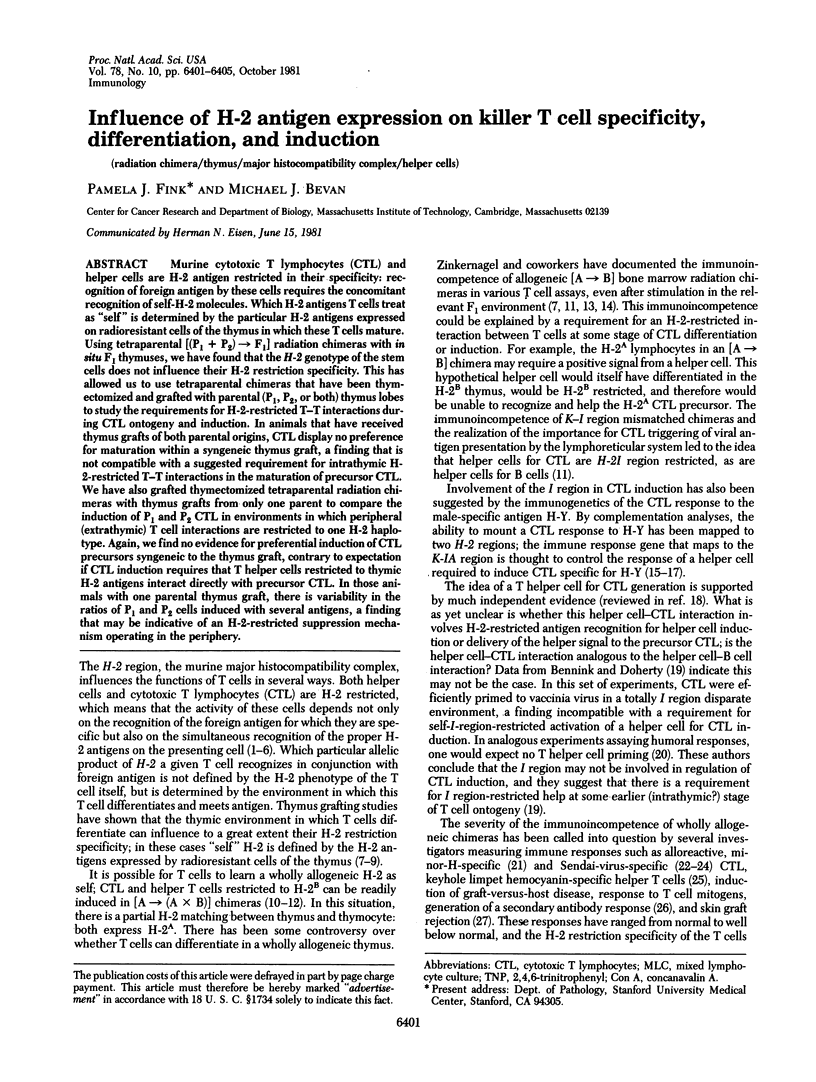
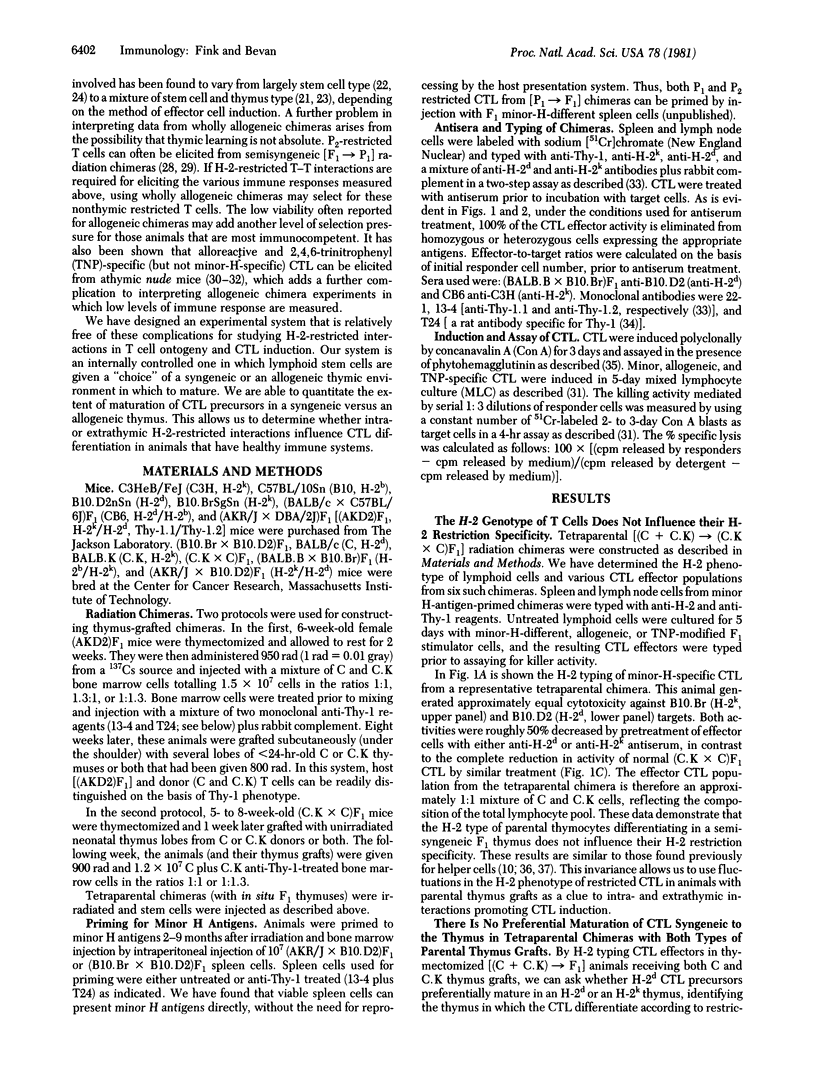
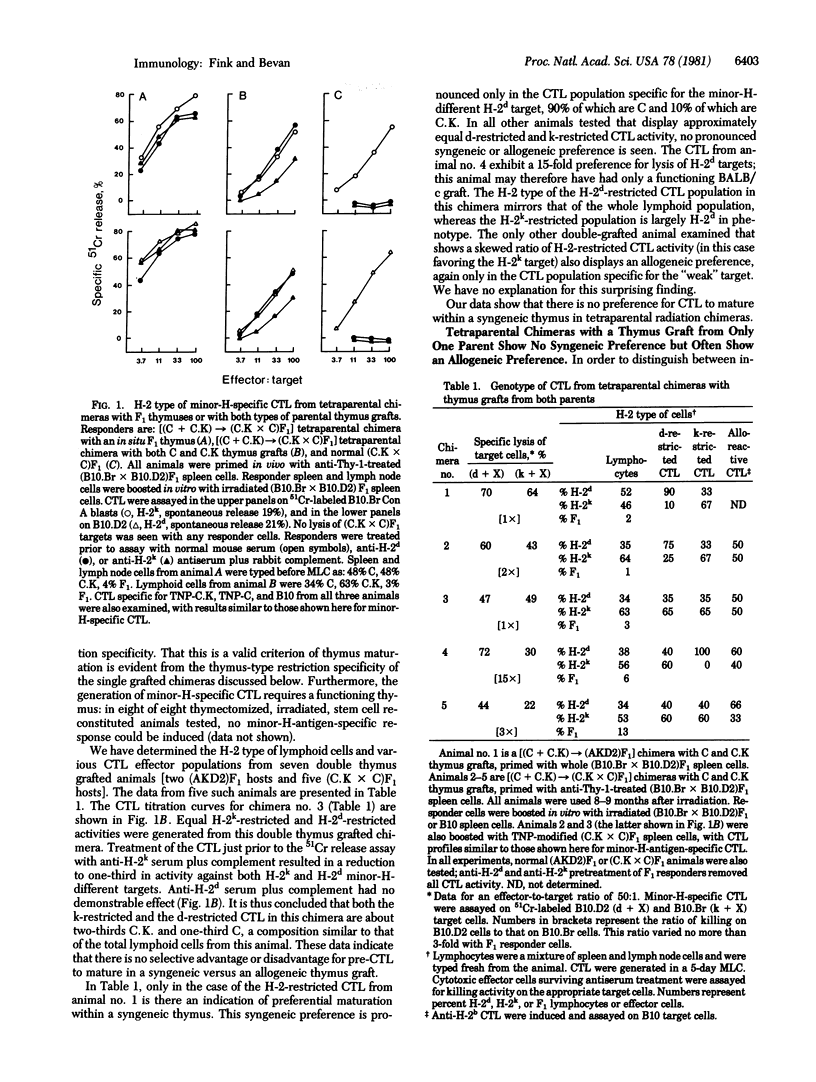
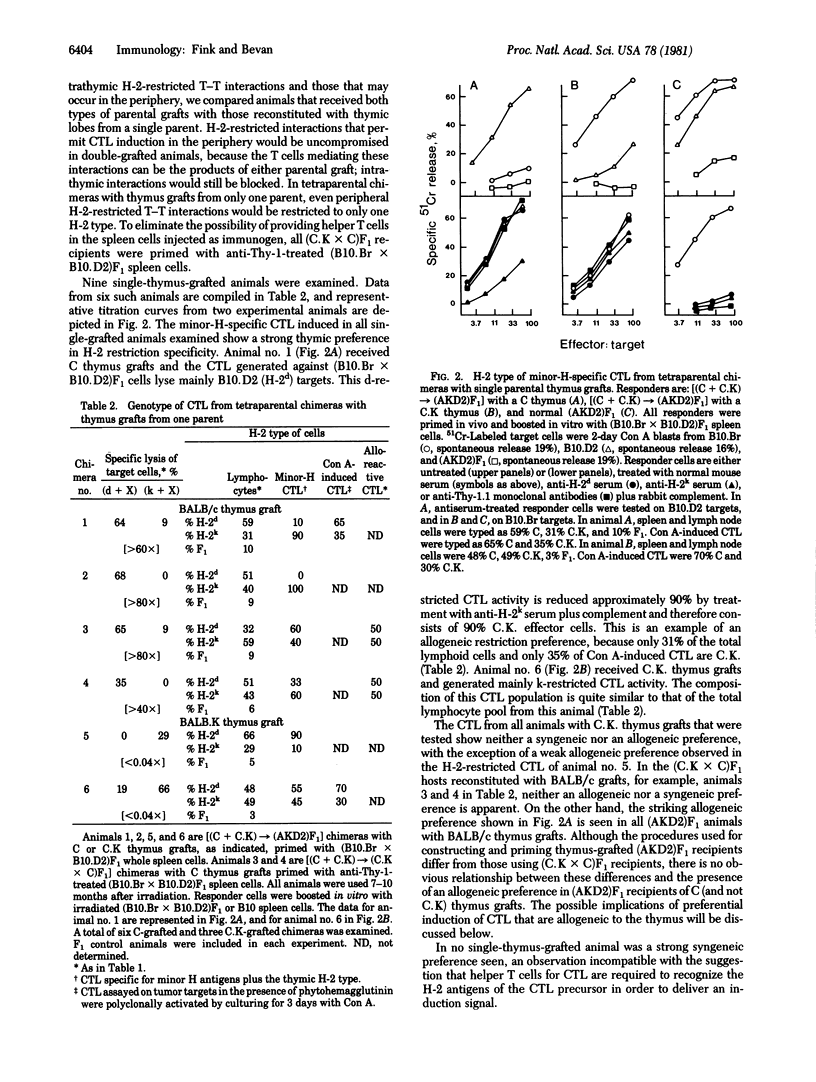
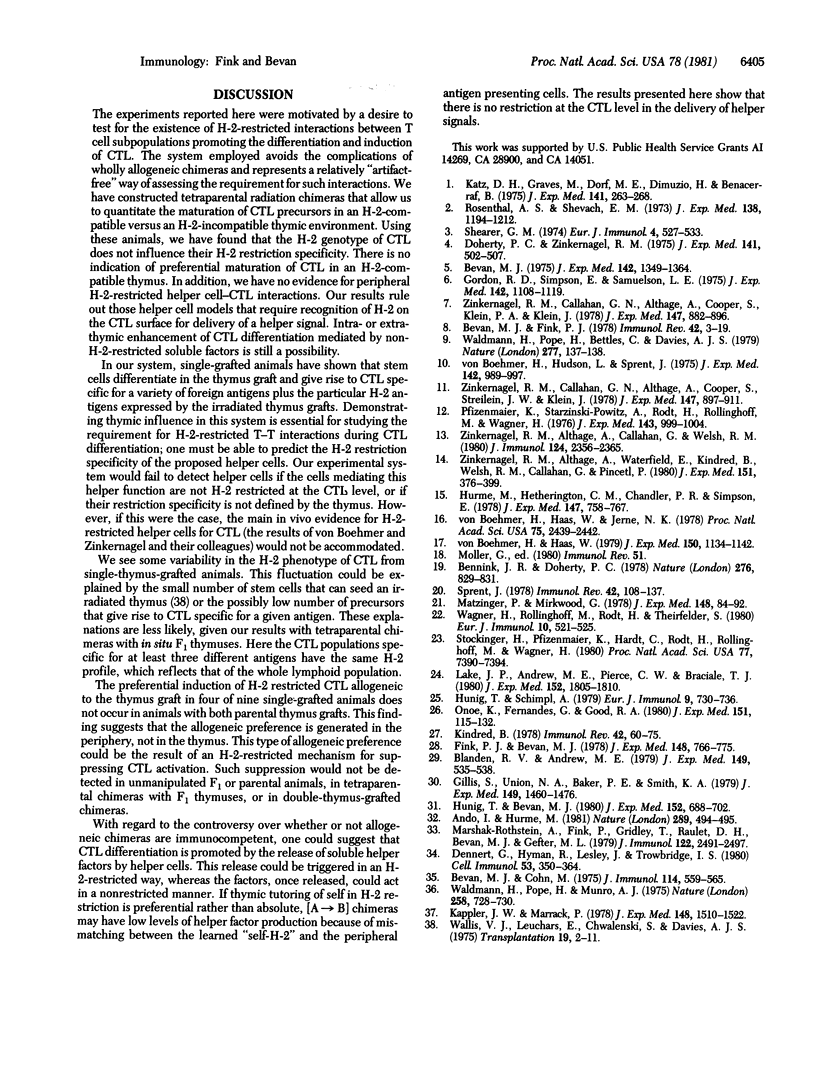
Selected References
These references are in PubMed. This may not be the complete list of references from this article.
- Ando I. Self-MHC-restricted cytotoxic T-cell response without thymic influence. Nature. 1981 Feb 5;289(5797):494–495. doi: 10.1038/289494a0. [DOI] [PubMed] [Google Scholar]
- Bennink J. R., Doherty P. C. Different rules govern help for cytotoxic T cells and B cells. Nature. 1978 Dec 21;276(5690):829–831. doi: 10.1038/276829a0. [DOI] [PubMed] [Google Scholar]
- Bevan M. J., Cohn M. Cytotoxic effects of antigen- and mitogen-induced T cells on various targets. J Immunol. 1975 Feb;114(2 Pt 1):559–565. [PubMed] [Google Scholar]
- Bevan M. J., Fink P. J. The influence of thymus H-2 antigens on the specificity of maturing killer and helper cells. Immunol Rev. 1978;42:3–19. doi: 10.1111/j.1600-065x.1978.tb00256.x. [DOI] [PubMed] [Google Scholar]
- Bevan M. J. The major histocompatibility complex determines susceptibility to cytotoxic T cells directed against minor histocompatibility antigens. J Exp Med. 1975 Dec 1;142(6):1349–1364. doi: 10.1084/jem.142.6.1349. [DOI] [PMC free article] [PubMed] [Google Scholar]
- Blanden R. V., Andrew M. E. Primary anti-viral cytotoxic T-cell responses in semiallogeneic chimeras are not absolutely restricted to host H-2 type. J Exp Med. 1979 Feb 1;149(2):535–538. doi: 10.1084/jem.149.2.535. [DOI] [PMC free article] [PubMed] [Google Scholar]
- Dennert G., Hyman R., Lesley J., Trowbridge I. S. Effects of cytotoxic monoclonal antibody specific for T200 glycoprotein on functional lymphoid cell populations. Cell Immunol. 1980 Aug 1;53(2):350–364. doi: 10.1016/0008-8749(80)90335-4. [DOI] [PubMed] [Google Scholar]
- Doherty P. C., Zinkernagel R. M. H-2 compatibility is required for T-cell-mediated lysis of target cells infected with lymphocytic choriomeningitis virus. J Exp Med. 1975 Feb 1;141(2):502–507. doi: 10.1084/jem.141.2.502. [DOI] [PMC free article] [PubMed] [Google Scholar]
- Fink P. J., Bevan M. J. H-2 antigens of the thymus determine lymphocyte specificity. J Exp Med. 1978 Sep 1;148(3):766–775. doi: 10.1084/jem.148.3.766. [DOI] [PMC free article] [PubMed] [Google Scholar]
- Gillis S., Union N. A., Baker P. E., Smith K. A. The in vitro generation and sustained culture of nude mouse cytolytic T-lymphocytes. J Exp Med. 1979 Jun 1;149(6):1460–1476. doi: 10.1084/jem.149.6.1460. [DOI] [PMC free article] [PubMed] [Google Scholar]
- Gordon R. D., Simpson E., Samelson L. E. In vitro cell-mediated immune responses to the male specific(H-Y) antigen in mice. J Exp Med. 1975 Nov 1;142(5):1108–1120. doi: 10.1084/jem.142.5.1108. [DOI] [PMC free article] [PubMed] [Google Scholar]
- Hurme M., Hetherington C. M., Chandler P. R., Simpson E. Cytotoxic T-cell responses to H-Y: mapping of the Ir genes. J Exp Med. 1978 Mar 1;147(3):758–767. doi: 10.1084/jem.147.3.758. [DOI] [PMC free article] [PubMed] [Google Scholar]
- Hünig T., Bevan M. J. Specificity of cytotoxic T cells from athymic mice. J Exp Med. 1980 Sep 1;152(3):688–702. doi: 10.1084/jem.152.3.688. [DOI] [PMC free article] [PubMed] [Google Scholar]
- Hünig T., Schimpl A. Studies on the generation and expression of H-2-controlled T helper function in chimeric mice: evidence for two levels of H-2 resitriction. Eur J Immunol. 1979 Sep;9(9):730–736. doi: 10.1002/eji.1830090912. [DOI] [PubMed] [Google Scholar]
- Kappler J. W., Marrack P. The role of H-2 linked genes in helper T-cell function. IV. Importance of T-cell genotype and host environment in I-region and Ir gene expression. J Exp Med. 1978 Dec 1;148(6):1510–1522. doi: 10.1084/jem.148.6.1510. [DOI] [PMC free article] [PubMed] [Google Scholar]
- Katz D. H., Graves M., Dorf M. E., Dimuzio H., Benacerraf B. Cell interactions between histoincompatible T and B lymphocytes. VII. Cooperative responses between lymphocytes are controlled by genes in the I region of the H-2 complex. J Exp Med. 1975 Jan 1;141(1):263–268. doi: 10.1084/jem.141.1.263. [DOI] [PMC free article] [PubMed] [Google Scholar]
- Kindred B. Functional activity of T cells which differentiate from nude mouse precursors in a congenic or allogeneic thymus graft. Immunol Rev. 1978;42:60–75. doi: 10.1111/j.1600-065x.1978.tb00258.x. [DOI] [PubMed] [Google Scholar]
- Lake J. P., Andrew M. E., Pierce C. W., Braciale T. J. Sendai virus-specific, H-2-restricted cytotoxic T lymphocyte responses of nude mice grafted with allogeneic or semi-allogeneic thymus glands. J Exp Med. 1980 Dec 1;152(6):1805–1810. doi: 10.1084/jem.152.6.1805. [DOI] [PMC free article] [PubMed] [Google Scholar]
- Marshak-Rothstein A., Fink P., Gridley T., Raulet D. H., Bevan M. J., Gefter M. L. Properties and applications of monoclonal antibodies directed against determinants of the Thy-1 locus. J Immunol. 1979 Jun;122(6):2491–2497. [PubMed] [Google Scholar]
- Matzinger P., Mirkwood G. In a fully H-2 incompatible chimera, T cells of donor origin can respond to minor histocompatibility antigens in association with either donor or host H-2 type. J Exp Med. 1978 Jul 1;148(1):84–92. doi: 10.1084/jem.148.1.84. [DOI] [PMC free article] [PubMed] [Google Scholar]
- Onoé K., Fernandes G., Good R. A. Humoral and cell-mediated immune responses in fully allogeneic bone marrow chimera in mice. J Exp Med. 1980 Jan 1;151(1):115–132. doi: 10.1084/jem.151.1.115. [DOI] [PMC free article] [PubMed] [Google Scholar]
- Pfizenmaier K., Strazinski-Powitz A., Rodt H., Röllinghoff M., Wagner H. Virus and trinitrophenol hapten-specific T-cell-mediated cytotoxicity against H-2 incompatible target cells. J Exp Med. 1976 Apr 1;143(4):999–1004. doi: 10.1084/jem.143.4.999. [DOI] [PMC free article] [PubMed] [Google Scholar]
- Rosenthal A. S., Shevach E. M. Function of macrophages in antigen recognition by guinea pig T lymphocytes. I. Requirement for histocompatible macrophages and lymphocytes. J Exp Med. 1973 Nov 1;138(5):1194–1212. doi: 10.1084/jem.138.5.1194. [DOI] [PMC free article] [PubMed] [Google Scholar]
- Shearer G. M. Cell-mediated cytotoxicity to trinitrophenyl-modified syngeneic lymphocytes. Eur J Immunol. 1974 Aug;4(8):527–533. doi: 10.1002/eji.1830040802. [DOI] [PubMed] [Google Scholar]
- Sprent J. Role of H-2 gene products in the function of T helper cells from normal and chimeric mice in vivo. Immunol Rev. 1978;42:108–137. doi: 10.1111/j.1600-065x.1978.tb00260.x. [DOI] [PubMed] [Google Scholar]
- Stockinger H., Pfizenmaier K., Hardt C., Rodt H., Röllinghoff M., Wagner H. H-2 restriction as a consequence of intentional priming: T cells of fully allogeneic chimeric mice as well as of normal mice respond to foreign antigens in the context of H-2 determinants not encountered on thymic epithelial cells. Proc Natl Acad Sci U S A. 1980 Dec;77(12):7390–7394. doi: 10.1073/pnas.77.12.7390. [DOI] [PMC free article] [PubMed] [Google Scholar]
- Wagner H., Röllinghoff M., Rodt H., Thierfelder S. T cell-mediated cytotoxic immune responsiveness of chimeric mice bearing a thymus graft fully allogeneic to the graft of lymphoid stem cells. Eur J Immunol. 1980 Jul;10(7):521–525. doi: 10.1002/eji.1830100707. [DOI] [PubMed] [Google Scholar]
- Waldmann H., Pope H., Beetles C., Davies A. J. The influence of thymus on the development of MHC restrictions exhibited by T-helper cells. Nature. 1979 Jan 11;277(5692):137–138. doi: 10.1038/277137a0. [DOI] [PubMed] [Google Scholar]
- Waldmann H., Pope H., Munro A. J. Cooperation across the histocompatibility barrier. Nature. 1975 Dec 25;258(5537):728–730. doi: 10.1038/258728a0. [DOI] [PubMed] [Google Scholar]
- Wallis V. J., Leuchars E., Chwalinski S., Davies A. J. On the sparse seeding of bone marrow and thymus in radiation chimaeras. Transplantation. 1975 Jan;19(1):2–11. doi: 10.1097/00007890-197501000-00002. [DOI] [PubMed] [Google Scholar]
- Zinkernagel R. M., Althage A., Callahan G., Welsh R. M., Jr On the immunocompetence of H-2 incompatible irradiation bone marrow chimeras. J Immunol. 1980 May;124(5):2356–2365. [PubMed] [Google Scholar]
- Zinkernagel R. M., Althage A., Waterfield E., Kindred B., Welsh R. M., Callahan G., Pincetl P. Restriction specificities, alloreactivity, and allotolerance expressed by T cells from nude mice reconstituted with H-2-compatible or -incompatible thymus grafts. J Exp Med. 1980 Feb 1;151(2):376–399. doi: 10.1084/jem.151.2.376. [DOI] [PMC free article] [PubMed] [Google Scholar]
- Zinkernagel R. M., Callahan G. N., Althage A., Cooper S., Klein P. A., Klein J. On the thymus in the differentiation of "H-2 self-recognition" by T cells: evidence for dual recognition? J Exp Med. 1978 Mar 1;147(3):882–896. doi: 10.1084/jem.147.3.882. [DOI] [PMC free article] [PubMed] [Google Scholar]
- Zinkernagel R. M., Callahan G. N., Althage A., Cooper S., Streilein J. W., Klein J. The lymphoreticular system in triggering virus plus self-specific cytotoxic T cells: evidence for T help. J Exp Med. 1978 Mar 1;147(3):897–911. doi: 10.1084/jem.147.3.897. [DOI] [PMC free article] [PubMed] [Google Scholar]
- von Boehmer H., Haas W. Distinct Ir genes for helper and killer cells in the cytotoxic response to H-Y antigen. J Exp Med. 1979 Nov 1;150(5):1134–1142. doi: 10.1084/jem.150.5.1134. [DOI] [PMC free article] [PubMed] [Google Scholar]
- von Boehmer H., Haas W., Jerne N. K. Major histocompatibility complex-linked immune-responsiveness is acquired by lymphocytes of low-responder mice differentiating in thymus of high-responder mice. Proc Natl Acad Sci U S A. 1978 May;75(5):2439–2442. doi: 10.1073/pnas.75.5.2439. [DOI] [PMC free article] [PubMed] [Google Scholar]
- von Boehmer H., Hudson L., Sprent J. Collaboration of histoincompatible T and B lymphocytes using cells from tetraparental bone marrow chimeras. J Exp Med. 1975 Oct 1;142(4):989–997. doi: 10.1084/jem.142.4.989. [DOI] [PMC free article] [PubMed] [Google Scholar]


